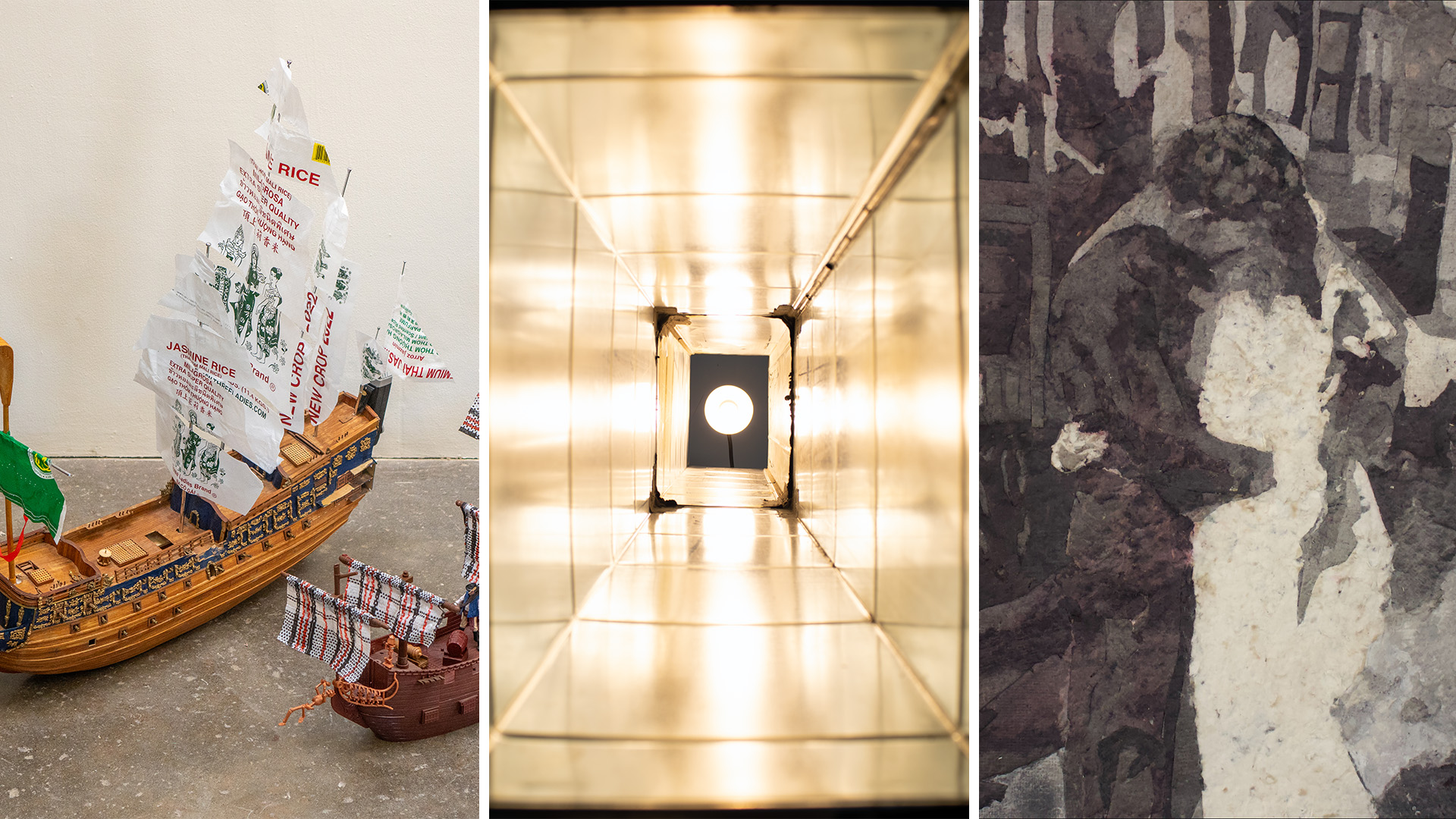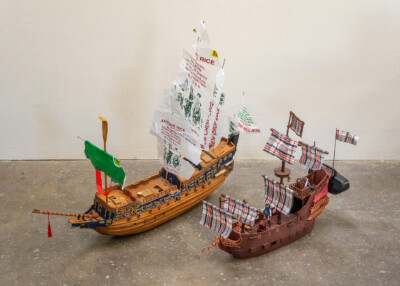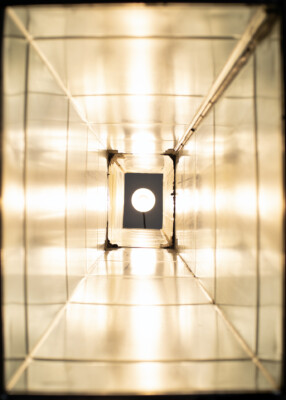
FOR IMMEDIATE RELEASE
The Artist in Residence Program at Recology San Francisco is thrilled to announce exhibition dates for current artists-in-residence Macro Waves, Darrin Martin, and SFSU Graduate Student Jake Shapiro.
Friday, September 15 from 5 PM – 8 PM
Saturday, September 16 from 12 PM – 3 PM
Tuesday, September 19 from 5 PM – 7:30 PM with artist talk by Jake Shapiro at 6 PM (401 Tunnel), Macro Waves at 6:30 PM (503 Tunnel), and Darrin Martin at 7 PM (503 Tunnel)
Location
Recology Art Studios
503 and 401 Tunnel Avenue, San Francisco
Admission is free and open to the public, no reservation required. All ages are welcome and the site is wheelchair accessible.

Macro Waves
Make This Last Forever
Macro Waves (Robin Birdd David & Jeffrey Yip) utilizes the framework of archiving to make sense of the intergenerational stories of movement and transition held in the objects we inherit–whether the things passed down directly by immigrant elders or our collective responsibility to contend with the growing mass of consumer waste.
Who is responsible for your things after you’re gone? And how do we honor and contend with the belongings of previous generations–especially when they’ve felt the need to hold onto everything as a means of survival? Macro Waves embraces the spirit of collection, reuse, and repair passed down to them as they seek out the memories and sentimentality of the objects they’ve gathered from the Public Reuse and Recycling Area. Along with cataloging a growing repository of 3D scans they’ve made of their accumulated objects, the artists interviewed San Francisco residents about their experiences managing the stuff they’ve had to sift through from their elders and how this has shaped the interviewees’ relationships to their own belongings.
Throughout the exhibition, e-waste generations too boxy and out of date–signal boosters, an AM radio, stacks of video screens–have been resuscitated to transmit and display the gathered interviews and digital archive of objects. This presentation of inherited objects and current day stories plays with our sense of time: talking backwards to earlier generations and our younger selves, as well as into the future. The crackly grain to this obsolete technology is a feature, not a bug. This is not seamless, high def precision. The artifacts that emerge from this passage of information from one generation to another–people and technology–gives each iteration its own sensibility.
This generative refiguration also manifests in other sculptural pieces, where materials like rice bags, recycled plastic takeaway containers, and colorful reusable shopping bags are remixed into sails for model boats, a lamp stand, or the backing of a folding chair. New artistic gestures live alongside and within found objects, infused with care and inherited knowledge.
Robin Birdd David and Jeffrey Yip, co-founders of Macro Waves, a California-based artist collective, produce experiences focusing on social equity through conceptual art, new media, and design. As artists, designers, and technologists of color, the collective embraces collaboration and community engagement in their creative practice of transforming spaces into places for human connection, exploration, and play. Macro Waves projects examine the systems, infrastructures, and processes of future world-building through science fiction-based narratives.
Macro Waves was the Featured Artist for the Asian Pacific Island Cultural Center’s 25th Annual United States of Asian America Festival, one of the recipients of the California Arts Council’s 2022 Impact Project Grant, and in 2020 participated in the Youkobo Artist Residency in Tokyo, Japan. The collective has exhibited at SFMOMA, SWIM Gallery, YBCA, SFAC Gallery, SOMArts, ICA SF, Lightbox NYC, and Á Space Hanoi.

Darrin Martin
Past Life Resonance
There is an almost imperceptible thrum to the world around us, a vibration in our everyday things and surroundings. In Past Life Resonance, Darrin Martin explores the possibilities of tuning in to these resonances embedded in the things we have thrown away. If sound is just vibrations, how might we listen to the embedded histories and internal textures of our trash? What might they tell us about how they want to be activated? Using a variety of artistic approaches, Martin taps into those secret echoes to make “the vibration of objects palpable.”
In many of the exhibited works, Martin taps into the narrative logic of found objects, drawing out the ecosystem of bits and sonic qualities they live within. In one section of the installation, the bow of a ship appears to be sinking into a sea of costume jewelry, the shiny bloom of plastic beads spreading around it. Martin uses the resonant chest of this boat half to amplify a marine soundscape–the slap of a halyard against a mast, the gurgle of activity at a marina. In another piece, he references the action movie trope of a protagonist sneaking through a building’s ventilation crawlspaces. A robotic vacuum cleaner runs through a section of ductwork with a mounted camera. These interior activities are only perceptible indirectly, through a monitor on the wall displaying the video feed and the shifting rumble as the machine trundles from one end to another.
Amidst this sonic environment, Martin also invites us to consider the silences. An array of flat screen televisions display looping views of 3D scanned children’s bikes and toy vehicles that show the wear and tear of love and use on their digital shells as they lie in the Public Reuse and Recycling Area. Even without an audio track the broken toys suggest crashes and accidents–an implied loudness. Next to the resurfaced sounds in the other pieces, the silence of this installation asks us to fill in the cacophony and imagine what embedded vibrations we might recover with our own creative tools if we observe closely enough.
Darrin Martin engages the synesthetic qualities of perception through video, performance, sculpture, and print-based installations. Influenced by his own experiences with hearing difference and disability studies, his projects consider notions of accessibility using tactility, sonic analogies, and audio descriptions.
His video works have screened internationally at venues including the Museum of Modern Art, Pacific Film Archive, Impakt Festival, and European Media Art Festival. His installations have exhibited at The Kitchen, Grand Central Art Center, Moscow State Vadim Sidur Museum, and, most recently, at SOMArts. Born and raised in New York, he holds an MFA from University of California, San Diego and is a Professor in Art and Art History at the University of California, Davis.

Jake Shapiro
The Memory Library Lends Life Through a Glimpse
Jake Shapiro welcomes us to the Memory Library, an imagined space built to reflect upon the piles of anonymous photographs he gathered while in residence at Recology. In the entryway to the exhibition, we are met with a mixed media, collaged set of bookshelves displaying photo albums and ephemera. Beyond the shelf, the space opens into a gallery of the artist’s paper pulp paintings reinterpreting moments captured by strangers’ cameras.
We are constantly inundated with photographic imagery. Online and in physical space, we live amidst a glut of snapshots–ads, personal social media posts, news and critical documentation. Making sense of our visual world requires a degree of numbness to the oversaturation, a reflexive swiping through, a blurring of our sight, a turn of the head. In an attention economy, consumption is not just the things thrown to the Public Reuse and Recycling Area, but where we lend our focus. In the Memory Library, Shapiro clears out space for us to consider a selection of photographs reinterpreted through handmade paper and paint. With each piece, we sort through details to fill in pieces of the story, deciphering the arrangement of the details we see and the ones we cannot. The lossy format of these new pieces demands that we spend time considering images taken by random strangers, encouraging us to re-familiarize ourselves with the practice of slow looking we all too often tamp down.
Jake Shapiro depicts collaged, fictional worlds that question cultural and social norms, putting the real and imaginary in conversation. Shapiro’s narratives are largely informed by his daydreams, where he disassembles and reassembles, omits things, and introduces fantastical elements. It is the action of disrupting that allows him to see better.
Shapiro was born and raised in Berkeley, CA. He has had solo exhibitions at Metal Haus Gallery in Oakland and Erica Tanov in Berkeley. He received the Christine Tamblyn Memorial Scholarship and the Martin Wong Painting/Drawing Scholarship and was the recipient of a Murphy-Cadogan Award in 2022. Shapiro is currently an MFA student in Art Practices at San Francisco State University entering his final year.
About the Artist in Residence Program
The Recology San Francisco Artist in Residence (AIR) Program is an art and education initiative that awards Bay Area artists access to discarded materials, an unrestricted stipend, and an individual studio space. These resources, along with comprehensive support, are provided to artists while they create a body of work and host studio visits during their four-month residency at the San Francisco Transfer Station.
Since 1990, over 150 professional artists and 50 student artists from local universities and colleges have completed residencies. Selected artists have worked across disciplines—including new media, video, painting, photography, performance, sculpture, and installation—to explore a wide range of topics.
The Recology AIR Program encourages the conservation of natural resources by providing artists with time, space, and reusable resources to create a new and impactful body of work. The Program further aims to create a more diverse and inclusive residency that amplifies perspectives from Bay Area communities and inspires children and adults who engage with the program to re-imagine their role in creating a just and sustainable world.